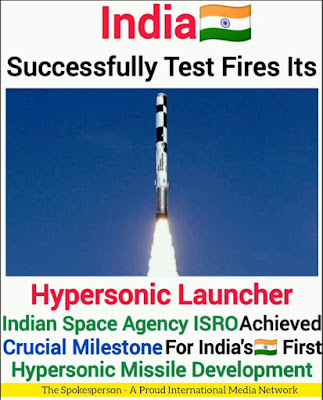ISRO successfully completes hypersonic vehicle test run, meets all targets
Indian Space Research Organisation (ISRO) announced Friday that the joint test run of hypersonic vehicles with Headquarters of the Integrated Defense Staff (HQ IDS) was successful.
A post on ISRO's official Twitter handle read: "ISRO and JSIIC have jointly conducted hypersonic vehicle trials. The trials achieved all required parameters and demonstrated hypersonic vehicle capability."
What is a hypersonic vehicle?
A hypersonic vehicle can be an airplane, missile, or spacecraft that has the ability to travel five times faster than the speed of sound, or greater than Mach 5. It is regarded as a cutting-edge technology, and countries like China, India, Russia, and the United States have been trying to further enhance the ability of their hypersonic weapons.
The Indian space agency has been developing hypersonic missiles in collaboration with Russia.
Indian scientists are also working on a project for an indigenous, dual-capable hypersonic cruise missile as part of its Hypersonic Technology Demonstrator Vehicle program. As per reports, the Indian indigenous missile will have the ability to fire nuclear weapons along with conventional weapons.
READ | SC quashes Kerala HC order granting bail to four police officials in ISRO spy case
ISRO completes first blow down test of Trisonic Wind Tunnel
ISRO has also completed the first blow down test of the newly-installed Trisonic Wind Tunnel at the Vikram Sarabhai Space Centre (VSSC), the space agency said.
The Trisonic Wind Tunnel is a system used to support aerodynamic design of rockets and re-entry spacecrafts by evaluating forces, moments, load distribution, and maintaining pressures and acoustic levels on a scaled model.
"The tunnel has an overall length of about 160 metres and has a maximum cross section of 5.4 meters. The tunnel can be used for testing various space vehicles in three flight regimes: below the speed of sound, at the speed of sound, and above the speed of sound: hence the name "trisonic wind tunnel." The tunnel can simulate flight conditions from 0.2 times the speed of sound (68 m/s) to 4 times the speed of sound (1360 m/s)," read the statement issued by the ISRO on its official website.



Comments
Post a Comment